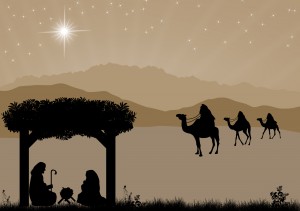Luke 2:7, Manger.
Manger. (Gr. phatne) The Greek word phatne literally means “feeding trough” and according to the word’s etymology and lexicology as stated in The TDNT, there is no indication that this manger is anything but a standard feeding trough or manger. Nevertheless, this manger may have been a sukkah or tabernacle, which is the flimsy little hut that Israelites build during the biblical Feast of Tabernacles (Heb. Chag Sukkot) as commanded in the Torah (Lev 23:33–43). Here’s why.
We see the connection between a manger and a sukkah in Genesis 33:17 where Jacob built booths (or tabernacles; Heb. succot or sukkot is the plural form of sukkah) for his livestock showing us that the Hebrew word sukkah (pl. sukkot) can also mean “livestock barn or manger” as well as a temporary habitation where Israelites dwell during the biblically commanded festival of Sukkot.
This raises the possibility that Yeshua was born in a festival sukkah during the Feast of Tabernacles or Sukkot and not just in an animal barn as Christian folklore would have us believe. The LXX Greek word for sukkah in Gen 33:17 is skenas meaning “habitation, dwelling or tabernacle” and is the same word used in John 1:14 and Rev 21:1–3 in reference to Yeshua tabernacling with his people.
Putting all the pieces together, Yeshua may have been born in a sukkah-manger prior to or during the Feast of Tabernacles with a human sukkah (or body, of which the physical sukkah during Sukkot is a metaphorical picture) in order to redeem man from sin, so that Yeshua might tabernacle with redeemed men forever in the New Jerusalem (Rev 21:3).



Shabbat Shalom Natan,thanks for breaking this down for all to understand.
Yes thank you and am sharing
I would be there with you in Oregon if I could. This ministry is such a great help to me. Praying 2016 will be a wonderful year for you Hoshana Rabbah, and the commonwealth of Israel residing there!
Thank you and likewise.
I believe Yahusha was born in a Sukkah as well as on Yom Sukkot.
His life patterned Yahuvah’s moedim.
I heard recently about a possible depression in a limestone rock. Somethings correlating to the Migdal Eder process? I forgot.
Also, would it have been possible to think since Mary was pregant and about to give birth to Yahusha, the family would jot want her in their home (Guest chamber, not inn) because of ritual uncleaness associated with blood? There are pieces in my mind I’m trying to put together to understand with context all this. Christianity paints a corrupt picture of this sacred event..
It’s my belief from things I’ve studied, that Yeshua was conceived on Chanukah in 4 BC as the light of the world. Nine months later he was born in a sukkah on the first eve of Sukkot in 3 BC. He was wrapped in swaddling clothes and placed in a bread box, (also referred to as a manger) where he represented the bread of life.
This timeline would put the birth of John the Babtist on Passover, (in the spirit of Elijah). Yeshua came on Sukkot, born in a sukkah as Immanuel! (God with us).
But isn’t the Greek word in Luke (for where Yeshua was born) phatna and not skenas?
Your are correct that the Greek word for manger is phatne. However, in my article, I never said that the word manger was the Greek word skene. You just assumed this. However, to make things clearer and so there is no future confusion, I rephrased the first sentence of this article.